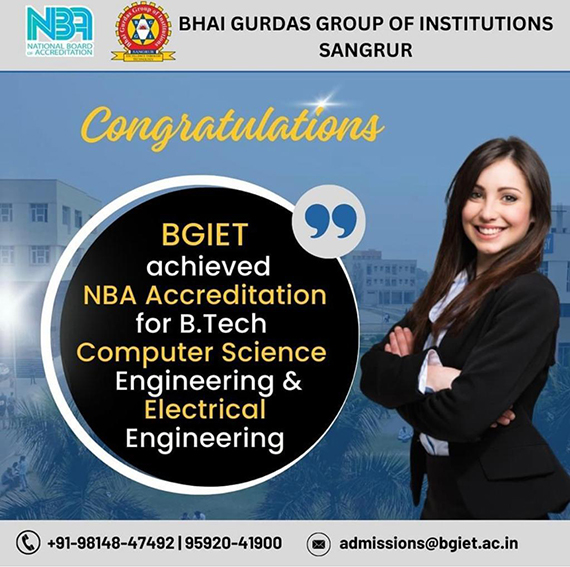Laboratories

Fluid Mechanics Lab
A basic knowledge of Fluid mechanics is essential for all the scientists and engineers because they frequently come across a variety of problems involving flow of fluids such as force of fluid on structural surfaces, fluid transport. This fluid mechanics lab helps to understand these physical processes more closely. The objective of this laboratory is to determine the various parameters related to fluid flow in pipes and in open channels.
List of Experiments
- To study of pressure measuring devices as peizometer, U-tube manometer, and
pressure gauges. - To verify Bernoulli’s Theorem
- To determine the Meta centric height of a Floating Body under different condition.
- To determine the coefficient of discharge of a Venturimeter.
- To determine the coefficient of discharge of a Orifice Meter.
- To determine the coefficient of friction of different diameter pipes.
- To estimate the minor losses as energy loss in pipe bend, sudden contraction or enlargement in pipe.
- To determine the coefficient of discharge on rectangular and V-notches.
- To determine the various element of a hydraulic jump.
Equipments/Apparatus
Venturimeter, Orificemeter, Pitot tube, Losses in Pipe Line Apparatus, Centrifugal Pump, Tilting
Fume, V- Notch Apparatus, Reynolds Apparatus, Stokes Law Apparatus.
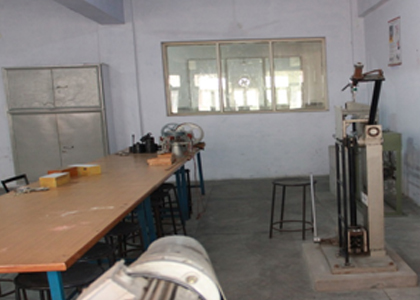
Solid Mechanics Lab
Purpose of this lab is to provide facilities to conduct various tests to calculate properties of the steel specimens. Since steel of various grades is used as main reinforcement material in most of the structures, so knowledge gained in this lab is imperative for proper understanding of the advance courses on design of steel/concrete structures.
List of Experiments
- Determination of physical properties of steel including strength and ductility.
- Study of tensile and compressive stress-strain behaviour of steel.
- Compression test on brick.
- Development of shear stress-strain curve for steel in torsion.
- Determination of hardness of a material by Rockwell and Brinell hardness testing machine.
- Determination of impact strength of a material by Izod and Charpy tests.
- Determination of bending strength of a wooden beam specimen.
- Determination of fatigue strength of a material.
- Study of behavior of columns and struts with different end conditions.
- To verify the moment area theorem for slope and deflection of a given beam.
Equipments/Apparatus
Major equipment in this lab includes Universal Testing Machine with extensometer and shear test attachment, digital torsion testing machine, impact testing machine, Brinell hardness testing machine, Rockwell hardness testing machine, digital spring testing machine and fatigue testing machine.
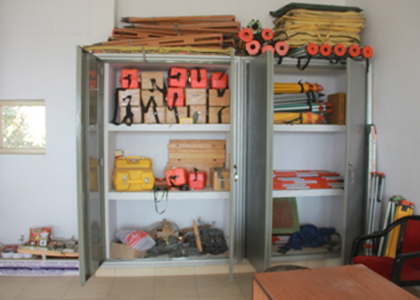
Surveying & Geomatics Lab
The objective of this laboratory is to enable the students to understand and practice the basic principles of surveying by conducting field exercises using a wide spectrum of surveying equipments. This laboratory covers data collection methods including surveying, profile leveling, contouring, compass traversing, laying out of curves, base line measurement and triangulation.
List of Experiments
- Measurement of bearing and angles with compass, adjustment of traverse by graphical method.
- Different methods of leveling, height of instrument, rise & fall methods.
- Measurement of horizontal and vertical angle by theodolite.
- Determination of tachometric constants and determination of reduced levels by tachometric observations.
- Plane table survey, different methods of plotting, three point problem.
- Determination of height of an inaccessible object.
- Setting out of circular curves in the field using different methods.
- Plotting of traverse using the Total Station and GPS.
Equipments/Apparatus
Arrows, Alidade, Auto level, Chain 20 m, Chain 30 m, Dumpy level, Theodolite, Levelling Staff, Plumb Bob, Prismatic Compass, Plane Table, Plumbing Fork, Tape 20 m, Tape 15 m, Tripod Stand, Trough Compass, Spirit level, Wooden Peg, Total-O-Station.

Concrete Technology Lab
The testing and inspection of concrete and concrete aggregates are important elements in obtaining quality construction. The laboratory allows students test to assess the various fresh and hardened concrete properties that may affect the performance of concrete members.
List of Experiments
1. Tests on cement
a. Finenessb.
b. Consistency
c. Setting time
d. Soundness
e. Specific gravity
f. Strength
2. Tests on aggregates (fine and coarse)
a. Specific gravity
b. Bulk Density
c. Fineness Modulus
d. Moisture content
e. Water Absorption
f. Bulking of sand
3. Design mix of concrete as per BIS method.
4. Workability tests on concrete
a. Slump test
b. Compaction Factor test
c. Vee-Bee test
5. Strength tests on concrete
a. Compressive strength (Cube and Cylinder)
b. Split Tensile strength
c. Flexural strength
d. Abrasion resistance
6. Non-Destructive Techniques
a. Rebound hammer test
b. Ultra sonic pulse velocity test
Equipments/Apparatus
Beam Mould (10x10x50), Beam Mould (10x10x20), Concrete Mixer, Compaction Factor, Compression Testing Machine Digital, Cube Mould (15×15cm), , Cylindrical Mould ( 15 x 30 ), Cylindrical Measure, Digital Ultrasonic Pulse Velocity, Digital Stop Watch, Density Spoon, Flexural Testing Machine, Gauging Trowel, Glass Thermometer, Hot Plate, Heat of Hydration, Le Chatelier Apparatus, Length & Thickness Gauge, Plastic Measuring Cylinder 100 ml, Plastic, Plastic Measuring Cylinder 500 ml, Plastic Measuring Cylinder 1000 ml, Pycnometer, Rubber Gloves, Rubber Mallet, Sieve Shaker Motorised, Slump Test, Standard Sand, Spatula 6”, Tamping Rod, Trimming Knife, Vee-Bee Consistometer, Vicat Needle, Standard test sieves (coarse and fine sets).
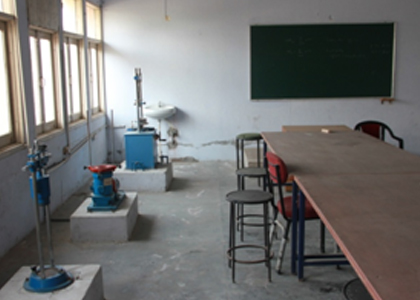
Transportation Lab
For the design the construction of highway and airfield, it is imperative to carry out tests on construction materials for their scientific designing and economic utilization. The prime objective of the different tests in use is to know and classify the pavement material into different group depending upon their physical and strength or stability characteristics.
List of Experiments
1. Tests on Sub-grade Soil
a. California Bearing Ratio Test
2. Tests on Road Aggregates
a. Crushing Value Test
b. Los Angles Abrasion Value Test
c. Impact Value Test
d. Shape Test (Flakiness and Elongation Index)
3. Tests on Bituminous Materials and Mixes
a. Penetration Test
b. Ductility Test
c. Softening Point Test
d. Flash & Fire Point Test
e. Bitumen Extraction Test
4. Field Tests
a. Study of Roughometer/Bump Indicator
b. Study of Benkelman Beam Method
Equipments/Apparatus
Ductility Testing Machine with Accessories, Aggregate Impact Tester, Bitumen Pentrometer with Accessories, Crushing Vane Apparatus with Accessories, Flash & Fire Apparatus, Los Angeles Machine with Accessories, Softening Point Apparatus with Accessories, Beaker (500 ml.),CBR Apparatus with Accessories, Elongation Gauge, Flakiness Gauge, Oven 24’’ X 24’’, Sieve Shaker, Bitumen Extractor, Bitumen Aggregate Mixer, Bitumen Melting Pan, Mixing Bowl.
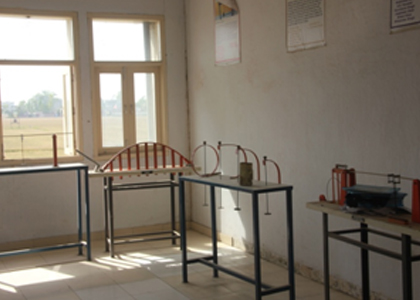
Structural Engineering Lab
The purpose of structure lab is to enable the students to understand and determine the effects of loads on civil structures and their components. Students can perform various tests as per the prescribed syllabus to understand the structural engineering concepts. Various apparatus such as arches, trusses etc. are available to understand the practical behaviour of structural components of buildings.
List of Experiments
- Deflection of a simply supported beam and verification of Clark-Maxwell’s theorem.
- To determine the Flexural Rigidity of a given beam.
- Deflection of a fixed beam and influence line for reactions.
- Deflection studies for an overhang beam and influence line for reactions.
- Structural Drawings of Reinforced Concrete Elements such as Beams, Slabs.
- Structural Drawings of Steel Elements such as Connections, Tension Members, Compression Members, Beams.
Equipments/Apparatus
Clark’s Maxwell Reciprocal Theorem Apparatus, Curved Member Apparatus, Column & Strut Apparatus, Dial Gauge, Elastically Coupled Member Apparatus, Magnetic Base, Redundant Joint Apparatus, Truss Apparatus, Unsymmetrical Bending Apparatus, Vernier Calliper.

Environmental Engineering Lab
The purpose of Environmental Engineering Laboratory is used to enable the students for conducting experimental study of impurities present in water and to create awareness among the students about the dangerous effects of these impurities present in water which causes environmental pollution. Various tests can be performed to assess the water quality standard, pollution load in sewage and working efficiency of sewage and other water treatment unit.
List of Experiments
- To measure the pH value of a water/waste water sample.
- To determine optimum Alum dose for Coagulation.
- To find MPN for the bacteriological examination of water.
- To find the turbidity of a given waste water/water sample
- To find B.O.D. of a given waste water sample.
- To measure D.O. of a given sample of water.
- Determination of Hardness of a given water sample
- Determination of total solids, dissolved solids, suspended solids of a given water sample.
- To determine the concentration of sulphates in water/wastewater sample.
- To find chlorides in a given sample of water/waste water.
- To find acidity/alkalinity of a given water sample
- To determine the COD of a wastewater sample.
Equipments/Apparatus
Beaker Graduated 250ml, pH meter, Balance Digital (0.01gm), BOD Bottle 125ml, Burette, COD Digestion Apparatus, Distillation Flask 250ml, Turbidity Meter, Conical Flasks, Glass Stirrer, Hot Air Oven, Magnetic Stirrer With Hot Plate, BOD Incubator Fitted S.S Chamber, Measuring Cylinder 250ml, Burette Stand With Clamp, Pipette, Silica Crucible, Separating Funnel, Filter Paper, Wash Bottle 250ml.
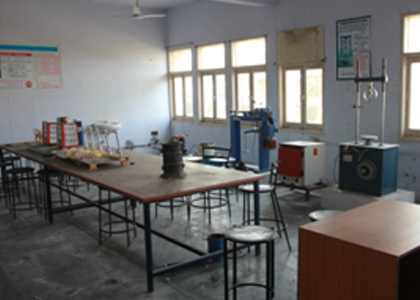
Geotechnical Lab
Soil Testing is an important part of civil engineering. The purpose of this lab is to enable students for carrying out proper evaluation of soil samples and analysis of test results. Facilities are available for determining various index and engineering properties of soil.
List of Experiments
- Determination of in-situ density by core cutter method and Sand replacement method.
- Determination of Liquid Limit & Plastic Limit.
- Determination of specific gravity of soil solids by pyconometer method.
- Grain size analysis of sand and determination of uniformity coefficient (Cu) and coefficient of curvature (Cc).
- Compaction test of soil.
- Determination of Relative Density of soil.
- Determination of permeability by Constant Head Method.
- Determination of permeability by Variable Head method.
- Unconfined Compression Test for fine grained soil.
- Direct Shear Test
- Triaxial Test
- Swell Pressure.
TestEquipments/Apparatus
Pyconometer, IS Sieves, Digital Oven 18” x 18”,Weighing Balance 20 kg, Weighing Balance 6 kg, Liquid Limit Kit, Plastic Limit Kit, Sand Replacement Kit, Core Cutter ( dolly + rammer ), Proctor ( mould + rammer ), Permeability ( mould + stand ), Unconfined Compression Testing Machine, Triaxial Machine with Spare, Direct Shear Machine.

